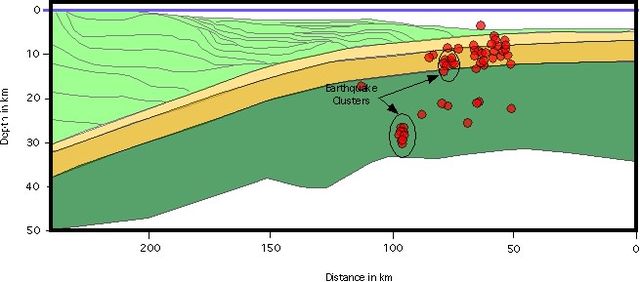The Nankai Trough is a submarine trough located south of the Nankaidō region of Japan's island of Honshu, extending approximately 900 km (559 mi) offshore. The underlying fault, the Nankai megathrust, is the source of the devastating Nankai megathrust earthquakes, while the trough itself is potentially a major source of hydrocarbon fuel, in the form of methane clathrate.
Depth of earthquake foci in cross section, modified from Obana, et al., 2002
Methane clathrate (CH4·5.75H2O) or (4CH4·23H2O), also called methane hydrate, hydromethane, methane ice, fire ice, natural gas hydrate, or gas hydrate, is a solid clathrate compound (more specifically, a clathrate hydrate) in which a large amount of methane is trapped within a crystal structure of water, forming a solid similar to ice. Originally thought to occur only in the outer regions of the Solar System, where temperatures are low and water ice is common, significant deposits of methane clathrate have been found under sediments on the ocean floors of the Earth (approx. 1100m below the sea level). Methane hydrate is formed when hydrogen-bonded water and methane gas come into contact at high pressures and low temperatures in oceans.
"Burning ice". Methane, released by heating, burns; water drips. Inset: clathrate structure (University of Göttingen, GZG. Abt. Kristallographie). Source: United States Geological Survey.
microscope image
Methane hydrate phase diagram. The horizontal axis shows temperature from -15 to 33 Celsius, the vertical axis shows pressure from 0 to 120,000 kilopascals (0 to 1,184 atmospheres). Hydrate forms above the line. For example, at 4 Celsius hydrate forms above a pressure of about 50 atm/5000 kPa, found at about 500m sea depth.
Gas hydrate-bearing sediment, from the subduction zone off Oregon





